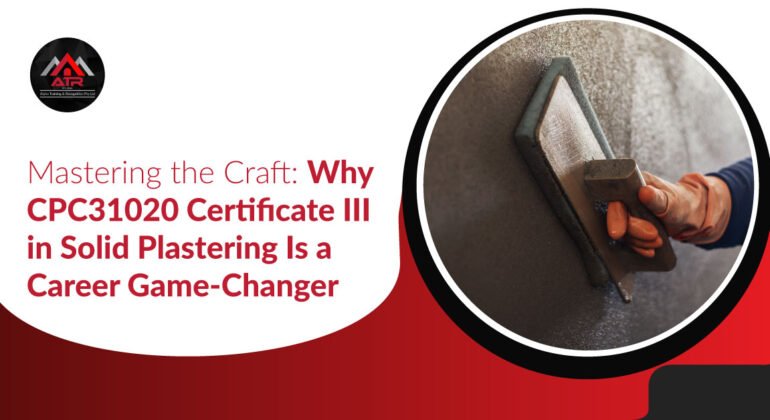In today’s fast-paced construction landscape, there is a growing appreciation for craftsmanship that combines tradition with innovation. As sleek, modern designs dominate Australian skylines, the value of solid plastering is being rediscovered. This timeless trade brings both structural integrity and aesthetic refinement to buildings, making it a key element in contemporary construction projects.
The CPC31020 Certificate III in Solid Plastering is more than a technical qualification—it is a pathway into a respected, hands-on trade that bridges the gap between old-world skills and new-world architecture. In this blog, we explore how this qualification equips learners with essential trade knowledge, opens up career opportunities, and supports Australia’s evolving construction needs.
Why Solid Plastering Still Matters in Modern Construction
Solid plastering is the craft of applying durable plaster coatings to interior and exterior walls and ceilings. This trade supports a wide range of finishes, from traditional textures to smooth, contemporary surfaces. Here’s why it remains highly relevant:
- Durability: Solid plastered surfaces offer excellent resistance to weather and wear, making them ideal for high-traffic or outdoor areas.
- Aesthetic Versatility: Techniques such as stucco, decorative cornices, and Venetian finishes allow for customisation across architectural styles.
- Fire and Moisture Resistance: Correctly applied plaster acts as an effective barrier against fire and humidity.
- Sound Insulation: Plaster adds mass to walls, reducing sound transmission—a valuable asset in residential and commercial builds.
- Sustainable Building: Plastering involves minimal synthetic materials and can often use lime- or clay-based mixes, reducing environmental impact.
Whether it’s a boutique hotel, a new residential complex, or a heritage-listed building, solid plastering adds craftsmanship that enhances both appearance and longevity.
Overview of CPC31020 Certificate III in Solid Plastering
This nationally recognised qualification is designed for individuals who want to master the techniques required for applying solid plaster. It blends practical training with theoretical knowledge, ensuring graduates are prepared to enter the workforce with confidence.
Key learning areas include:
- Applying float and render finishes to straight and curved surfaces
- Installing pre-cast and decorative mouldings
- Fixing fibre cement boards and specialist plasters
- Interpreting construction plans and specifications
- Ensuring safety and compliance on construction sites
- Surface preparation and finishing for durability and visual appeal
- Using traditional and modern tools for different plastering techniques
The course also introduces students to restoration and heritage work, a sector where plastering is especially important due to the need to match historical detailing and finishes.
Tools and Materials of the Trade
Mastering solid plastering requires both skill and familiarity with a range of tools and materials. Learners in the CPC31020 course train with:
- Trowels, hawks, and straightedges for precise finishing
- Mixing and application tools for base coats and top coats
- Plastering floats for achieving smooth or textured finishes
- Measuring tools and levels for accuracy and quality
Material knowledge includes working with:
- Cement-based plasters
- Lime and gypsum mixtures
- Acrylic and polymer-modified coatings
- Adhesives and bonding agents
By mastering these tools and materials, graduates develop a level of precision that is vital for large-scale projects and bespoke finishes.
Skills That Set You Apart
Graduates of the CPC31020 Certificate III gain more than trade ability—they develop critical thinking and problem-solving skills that can be applied to unique architectural challenges. These include:
- Precision in application for high-end architectural finishes
- Adaptability in working with different materials and surfaces
- Technical drawing literacy for executing complex designs
- Worksite communication skills for collaborating with other trades
- Project efficiency through proper planning and sequencing of work
Such a skill set not only makes graduates employable but highly valued on specialised builds where attention to detail and finish are critical.
Career Pathways and Industry Demand
Solid plastering is a trade with growing relevance in both heritage restorations and modern building developments. Qualified plasterers can work across:
- Residential housing – New builds, renovations, and custom interiors
- Commercial construction – Offices, hotels, retail, and public infrastructure
- Interior design and custom renovation – High-end bespoke finishes
- Heritage conservation projects – Restoring period buildings and facades
Career progression may include:
- Site supervisor roles on finishing crews
- Specialist plastering contractor for decorative or commercial projects
- Interior detailing consultant for luxury fit-outs
- Small business ownership in plastering and architectural finishes
Due to the aging workforce and a shortfall of new apprentices in this trade, there’s a real demand for skilled plasterers across Australia.
Earning Potential and Job Security
Solid plasterers enjoy stable employment with strong earning potential. Entry-level workers may start with hourly wages of $30–$40, while experienced tradespeople or subcontractors can earn significantly more depending on project scope and specialisation.
Plastering is part of a long-term trade with:
- Low barriers to entry but high skill ceilings
- Opportunities to specialise and increase rates
- High demand across public, private, and luxury sectors
With the right skills, plasterers can expand into related areas like rendering, fireproofing, or ornamental detailing—all of which pay premium rates.
Why Choose Alpha Training & Recognition (ATR)
When you enrol in the CPC31020 Certificate III in Solid Plastering with Alpha Training & Recognition (ATR) – RTO 45282, you benefit from our commitment to practical, job-ready education.
ATR is a nationally trusted RTO with:
- Experienced trainers with years in the plastering and finishes trade
- Flexible training delivery to suit working professionals and apprentices
- Strong ties to construction employers, giving students better career outcomes
- A modern approach that blends traditional skills with industry innovation
We ensure you graduate with both the skill and the confidence to excel in your career. Our training facilities simulate real job sites, and our curriculum reflects what employers demand on today’s high-end builds.
Key Benefits of Solid Plastering as a Career
Eco-friendly and low-waste techniques
Job security in essential trade work
Growth potential with advanced certifications
Opportunities in both modern and heritage sectors
Creative and hands-on work environments
Competitive earnings with specialist potential
Business ownership opportunities
Conclusion
Solid plastering is not a lost art—it’s a resurging trade that blends tradition with technical excellence. As Australian construction continues to evolve, the demand for quality finishes and skilled tradespeople will only increase.
The CPC31020 Certificate III in Solid Plastering offers a direct pathway into meaningful, high-value work. With Alpha Training & Recognition (ATR), you’ll gain the tools, training, and support to master your craft and build a rewarding career.
Craft tradition. Create modern spaces. Build your future with CPC31020.



